Few food trends have soared in popularity the last few years compared to the pandemic past-time of baking your own sourdough bread. But what's the nutritional deal with this trendy loaf?
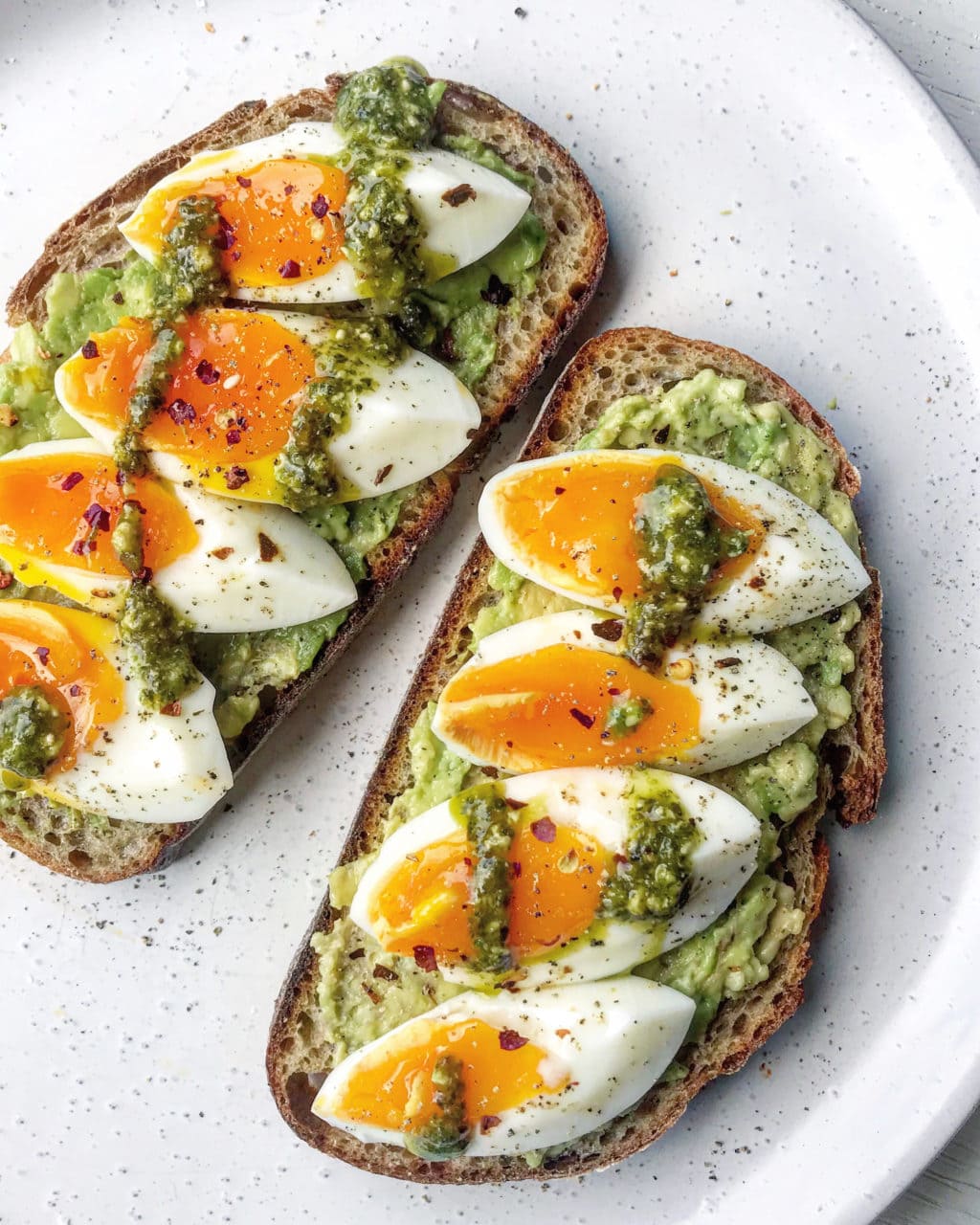
Artisan-style bread baking has been on the rise. As a means to stifle lockdown induced boredom and anxiety, many households have taken up the act of transforming flour into artfully crusted sourdough bread loaves.
It’s not hard to see why. Baking engages us mindfully – from mixing, rising, baking to sharing. With time a necessary ingredient, there’s a sense of achievement from the start(er…geddit?) to end – something tangible, carb-rich and delicious.
While sourdough is a great base for easy toast recipes, what’s the nutritional lowdown on this old school bread? I’ve got my nutritionist hat on for this blog – read on to explore dietary perks of sourdough, along with healthy toast topping ideas.
This post is divided into 4 parts. Keep scrolling to read on or click on any of the following links to go direct to that section:
1) What is sourdough bread?
2) Nutritional benefits of sourdough bread
3) Nutrition Q+A
4) Recipe ideas
What is Sourdough Bread?
Sourdough is a naturally leavened bread, meaning it doesn’t require commercially-produced yeast to rise. Instead, it uses a ‘sourdough starter’, a live culture made from flour and water.
Sourdough starters can be easily made at home. By combining flour and water, wild yeast and bacteria in the flour (and the air and on your hands too!) quickly thrive and ferment into a symbiotic community of microbes.
Within a week or so, a culture will develop through regular feeding (it’s alive!) and keeping living conditions happy and favourable for your new friends.
Here’s where it gets fun – fast forward to the bread-making process, a mature starter can be used again and again to leaven, aka raise, bread. When the microbes feed on sugars in the flour, bubbles of carbon dioxide gas are created and start to rise, expanding and ‘lifting’ the dough. Nifty, eh?
While commercial yeast is a speedy and reliable leaven, it’s made from just a single strain of yeast. Wild cultures, in contrast, contain an array of bacterial and yeast varieties that bring culinary perks galore, like a naturally slower, drawn-out fermentation affair – meaning more time to tease out complex flavours. Wild cultures also house good lactobacilli bacteria who produce lactic acid, the fundaments of that tangy signature taste we associate sourdough with. Finally, that natural acidity also discourages other bacteria – which means a loaf that keeps fresh longer!
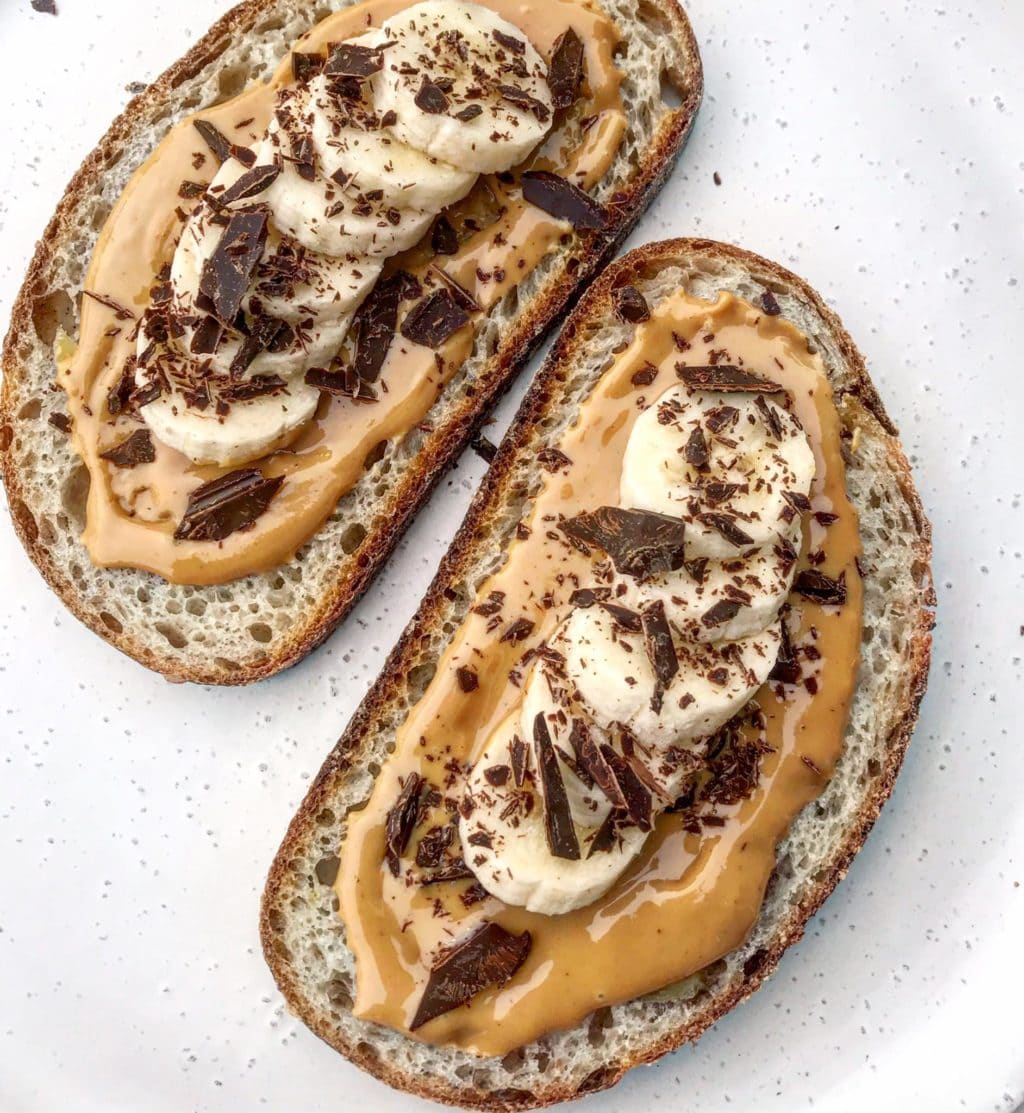
Nut butter, banana and dark chocolate🍌🍫 A lush combo of creamy, sweet and bitter. You can switch up the nut butters, but peanut butter is the OG.
Nutritional Benefits of Sourdough Bread
In the wild world of nutrition, the nutritional value of a food isn’t just the sum of its ingredients – how it’s prepared matters too. Sourdough’s fermentation process introduces a whole slew of possible nutritional benefits, including:
1) Better Mineral Absorption
Whole grain breads can be a great source of micronutrients, like the minerals iron, zinc and magnesium. Rather problematically, phytic acid (a natural substance found in many plant-based foods, like grains) can bind to these minerals, hindering their uptake by the body.
During fermentation, the lactic acid bacteria found in sourdough lower the pH of the dough (aka it becomes more acidic). This helps degrade, or break down, phytates (1). With lower phytate levels the bioavailability of minerals in the end loaf improves – meaning we’re able to access and absorb these nutrients more easily (2). Nutritional wins!
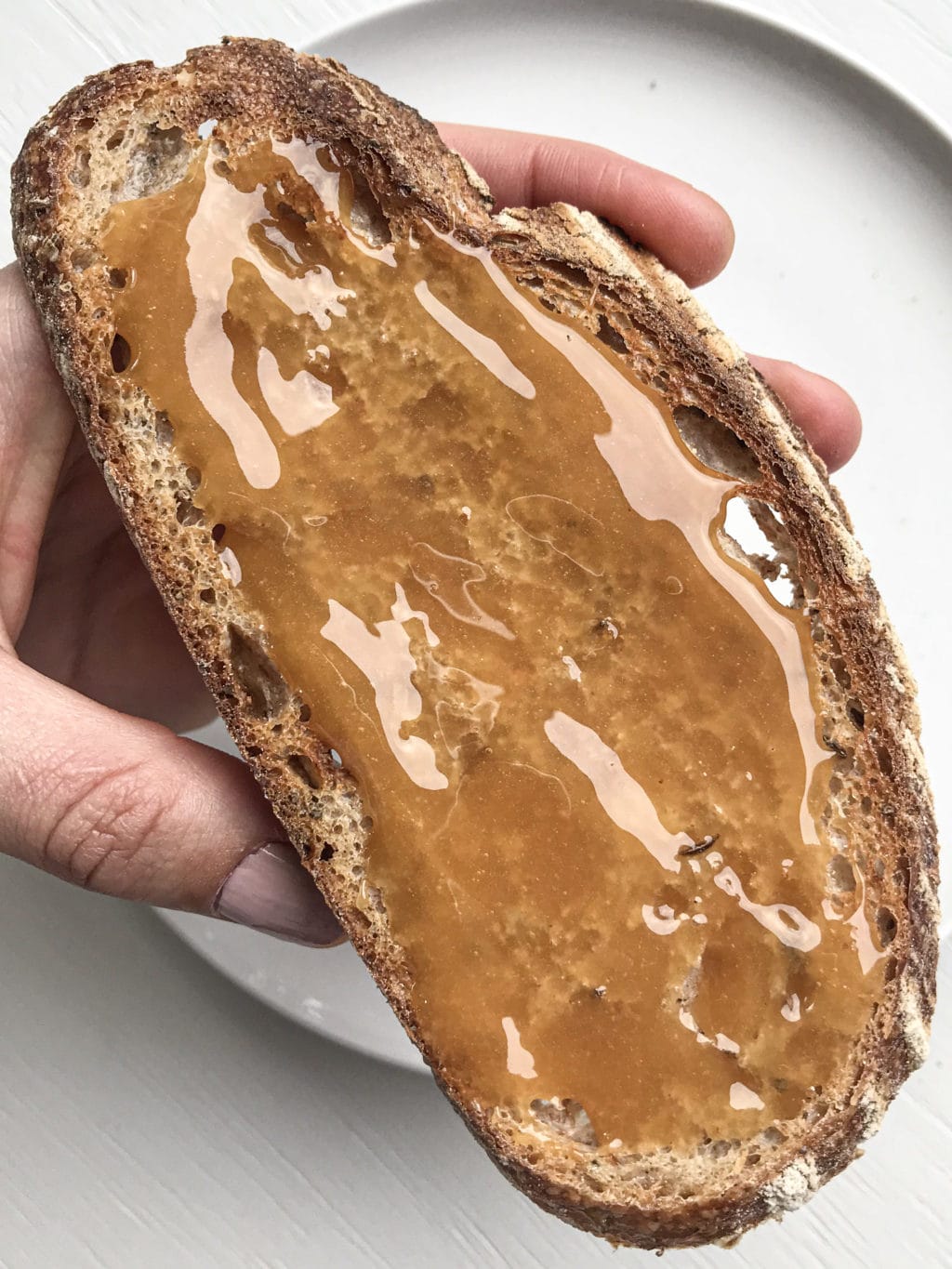
Mānuka Honey & butter🍯 This hedonic combo of fat + sugar = tastebud bliss. Mānuka honey is a unique spread, world-famous but indigenous to NZ. It’s associated with its own nutritional benefits.
2) Easier Digestibility
Gluten is the general name for proteins found naturally in wheat, rye and barley. It’s handy, as it helps foods maintain their shape – think of it like a stretchy ‘glue’!
The long drawn-out process of sourdough fermentation starts to break down some of the gluten, lowering the total count (3). This may make an end sourdough loaf easier to digest for some.
While certain bread lovers may be rejoicing at this news, gluten isn’t totally degraded. So, those with coeliac disease, or an intolerance where they feel better without any, need to still steer clear of sourdough made with wheat, rye and barley.
Did you know, from starter to end loaf, you can still make delicious sourdough using gluten-free flour? Check out the internet for some recipe ideas🍞
3) Prebiotic Benefits
Prebiotics are types of non-digestible dietary fibres and polyphenols (types of plant compounds) that feed our gut bacteria (4). By giving the good bugs foods they like to eat, this help them flourish and do all sorts of handy biological work for us in return.
During sourdoughs fermentation process, the properties and bioavaliablity of polyphenols and dietary fibre improve (2). This may offer up a better fuel source for our gut bugs – and in the bigger picture, improved digestive health.
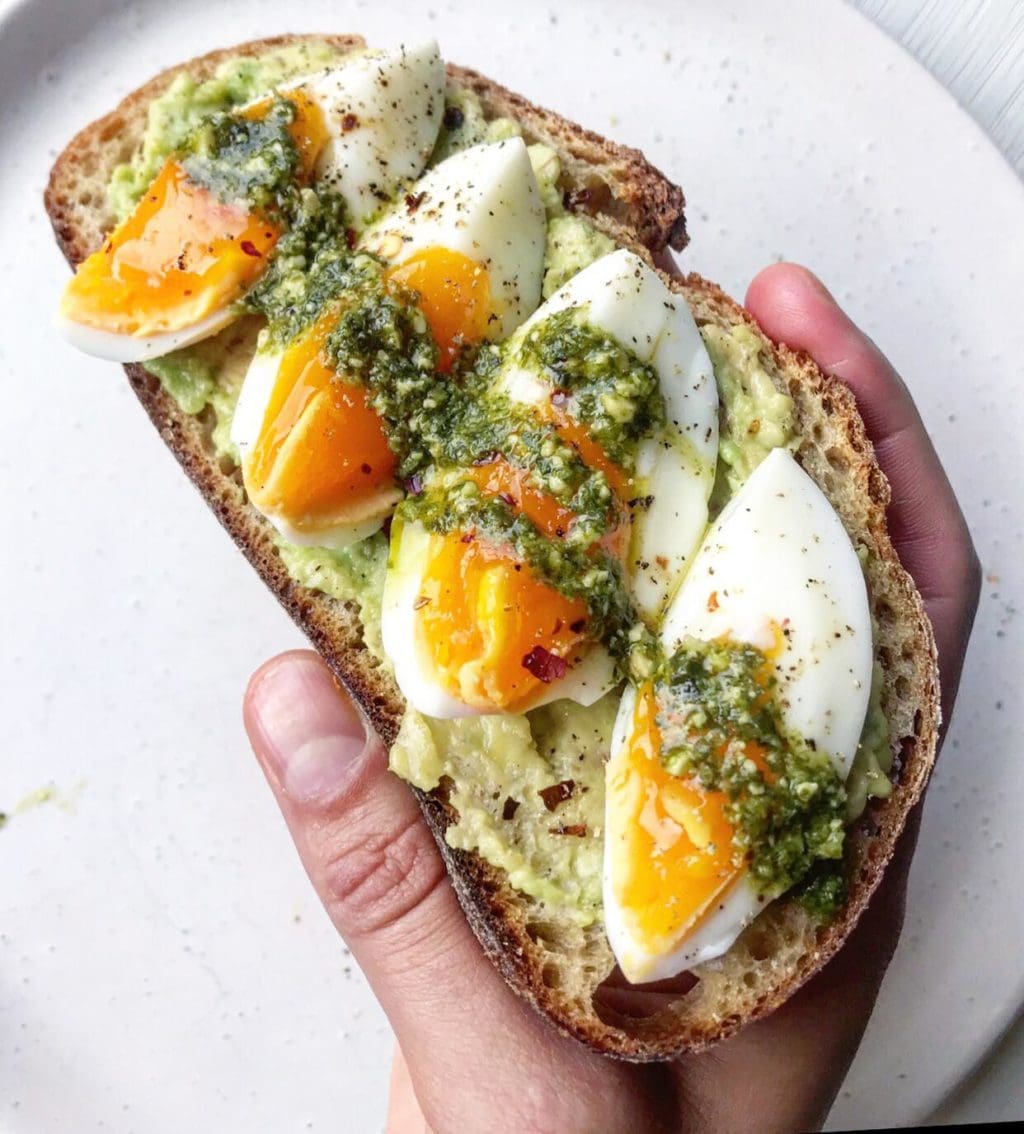
Egg, pesto and avocado on sourdough toast🥑🥚 A flavourful combo of slow-digesting whole food fat and protein to help keep you satisfied between meals.
4) Blood Sugar Control
Bread is a rich source of carbohydrates and, because of this, causes blood sugar levels to rise when eaten. People with certain health conditions, like type two diabetes, need to be particularly mindful of their blood sugar level balance.
Some research has shown that sourdough fermentation may cause change to the structure of carbohydrate molecules. This can reduce its glycemic index, slowing the speed at which sugars enter the bloodstream (5).
Further studies have shown that the flour breads are made with matters too. A dough derived from sprouted grains may trump white or wholemeal sourdough bread with a lower impact on blood sugar levels (6).
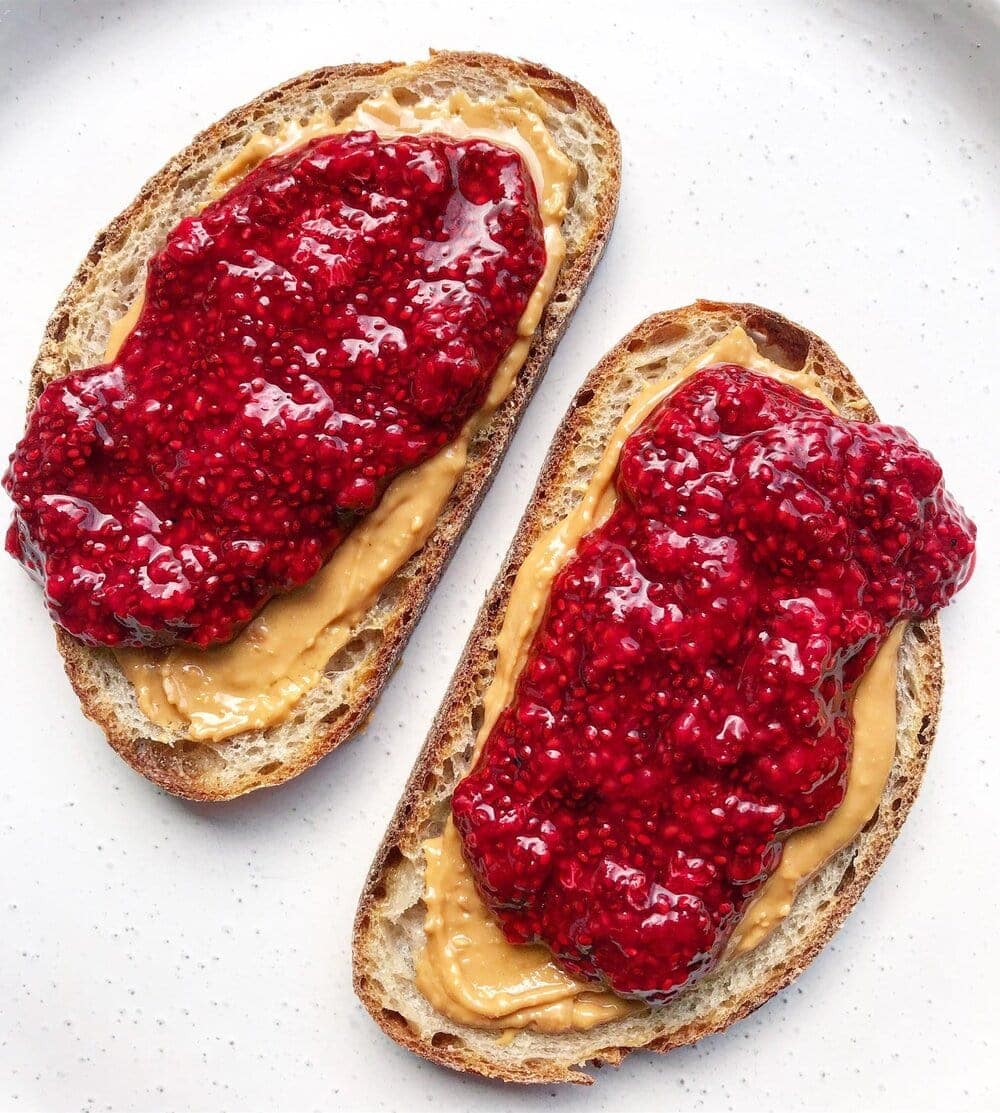
PB & chia jelly! For a bit of foodie fun, try making your own chia seed jam🍓 These tiny nutrient-dense seeds are rich in dietary fibre – when added to a liquid, they soak it up, thickening the mix into a jammy consistency🤙
5) A Vehicle for Other Nutritious Ingredients
What’s toast without its topping? Sourdough can be a fabulous mouth-to-stomach vehicle for other nutritious ingredients.
What graces the top of your toast has the ability to turn it into an easy balanced meal no matter whether it’s breakfast, lunch, dinner or snacktime.
A great nutritional strategy is to top your carb-rich toast with a protein (e.g. tuna, cheese, mashed edamame) or fat-rich food (e.g. avocado, hummus, butter). Not only will this add more nutritional variety into the mix, but also help keep you full for longer!
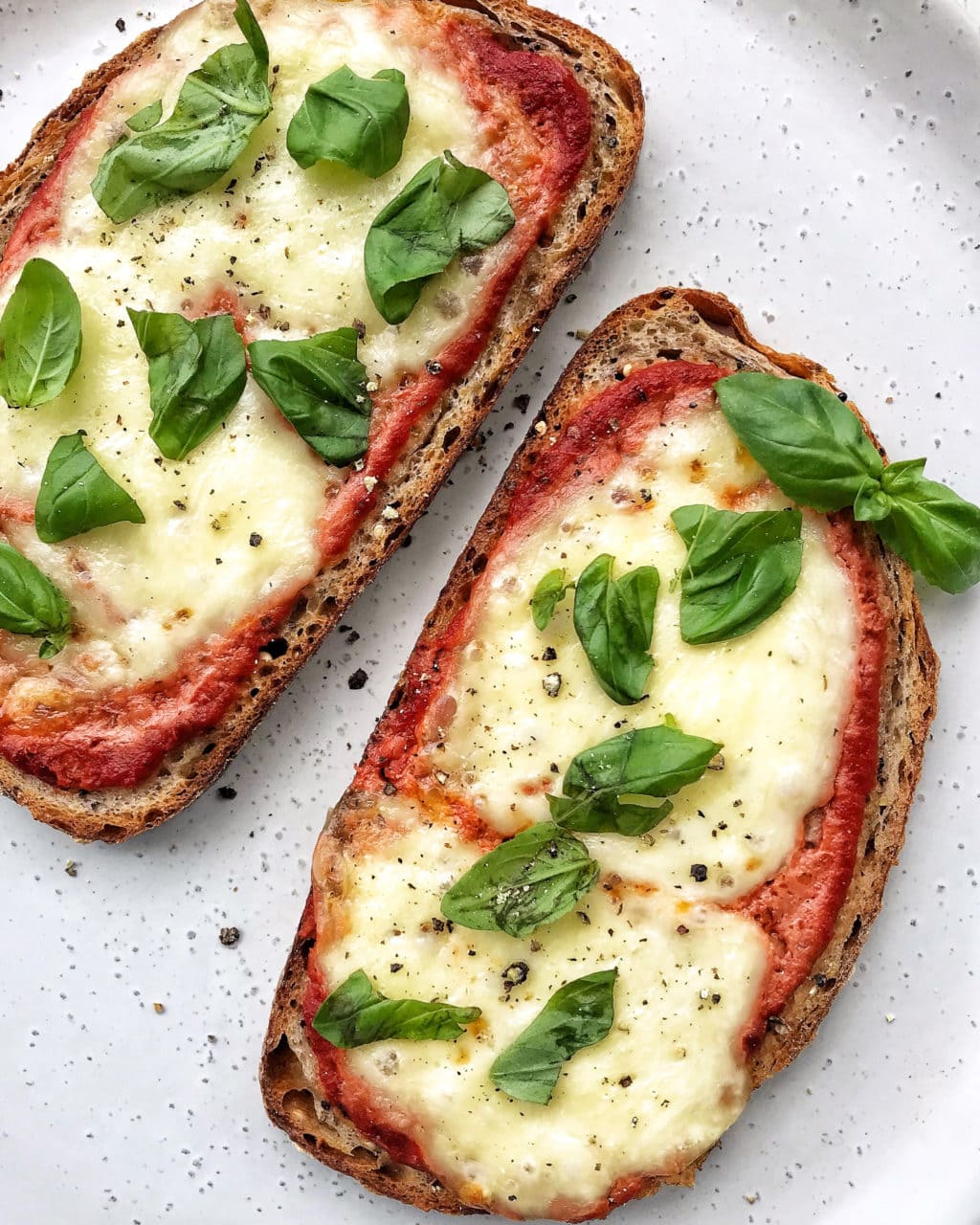
What do you get when you cross classic grilled cheese with Pizza Margherita?🇮🇹 These delicious vegetarian pizza toast! Each slice provides a source of whole grains, fibre and protein.
Quick-Fire Nutrition Q&A
Here are answers to commonly asked questions about sourdough nutrition:
- Is sourdough bread gluten free? Gluten is the name of a group of proteins found in wheat, rye and barely. The main ingredient in sourdough bread is typically wheat flour, which contains gluten. While sourdough varieties can be made with a gluten-free starter and flour (nifty!), sourdough bread isn’t innately gluten-free.
- Does sourdough bread have dairy? No. In classic sourdough recipes you’ll likely find just three ingredients – water, flour and salt. When in doubt, always check the ingredients. Some crafty folk might great creative with ingredient add-ins (cheesy sourdough anyone?).
- Is sourdough bread vegan? Yes. Animal products shouldn’t feature in traditional recipes. Once again, be mindful of ingredient add-in’s.
- Is sourdough bread low carb? No – with wheat flour the main ingredient, sourdough is high in carbohydrates. If you enjoy a low carb diet, this doesn’t mean it’s off the table though. A low carb diet isn’t a carb free die – you might be able to enjoy sourdough within your allocated carbohydrate intake.
- Does sourdough bread contain probiotics? This is a super interesting one! The starter contains probiotics…the good bacteria is what makes gives the starter its leavening super powers after all. However, once the loaf is baked, probiotics die off due to high oven temperatures.
- Does sourdough bread have yeast? Yes. As we’ve learnt, sourdough bread champions a starter that uses a population of wild yeast – on your hands, and in the environment – to leaven bread. However, bakers yeast, the kind you’ll often find at the supermarket, is not used.
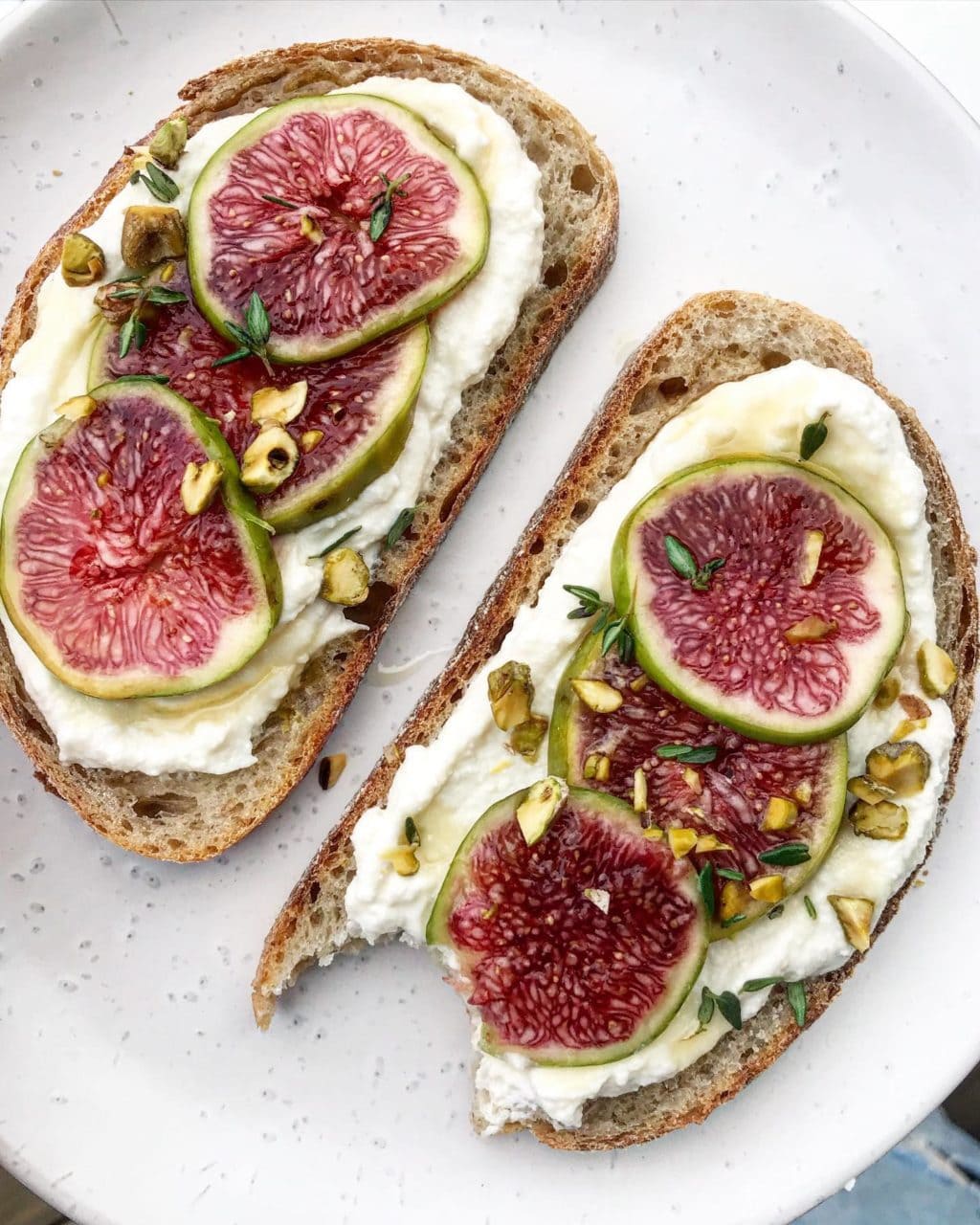
Ricotta whipped with lemon juice, topped with freshly sliced figs, chopped pistachios, fresh thyme leaves and honey🍯 The toast of my dreams!
To Wrap Up…& Recipes!
A revival of reduced-carb diets has seen some unfortunate villianisation of grains over the last few years.
Bread can be a great source of varied nutrients (like energy, fibre, protein, b vitamins and minerals), an accessible food for many, and an epic vehicle for other healthy ingredients. Ultimately, it can be an excellent building block as a part of a balanced, nutritious diet.
In sourdoughs case, its unique fermentation process may provide some additional nutritional benefit – while also being just darn delicious too.
Thanks for reading!🍞 Check out the recipe card below for ideas on how to eat sourdough, featuring all the toast topping ideas you’ve scrolled past in this post.
Nutritional Benefits of Sourdough Bread + 6 Healthy Toast Topping Ideas
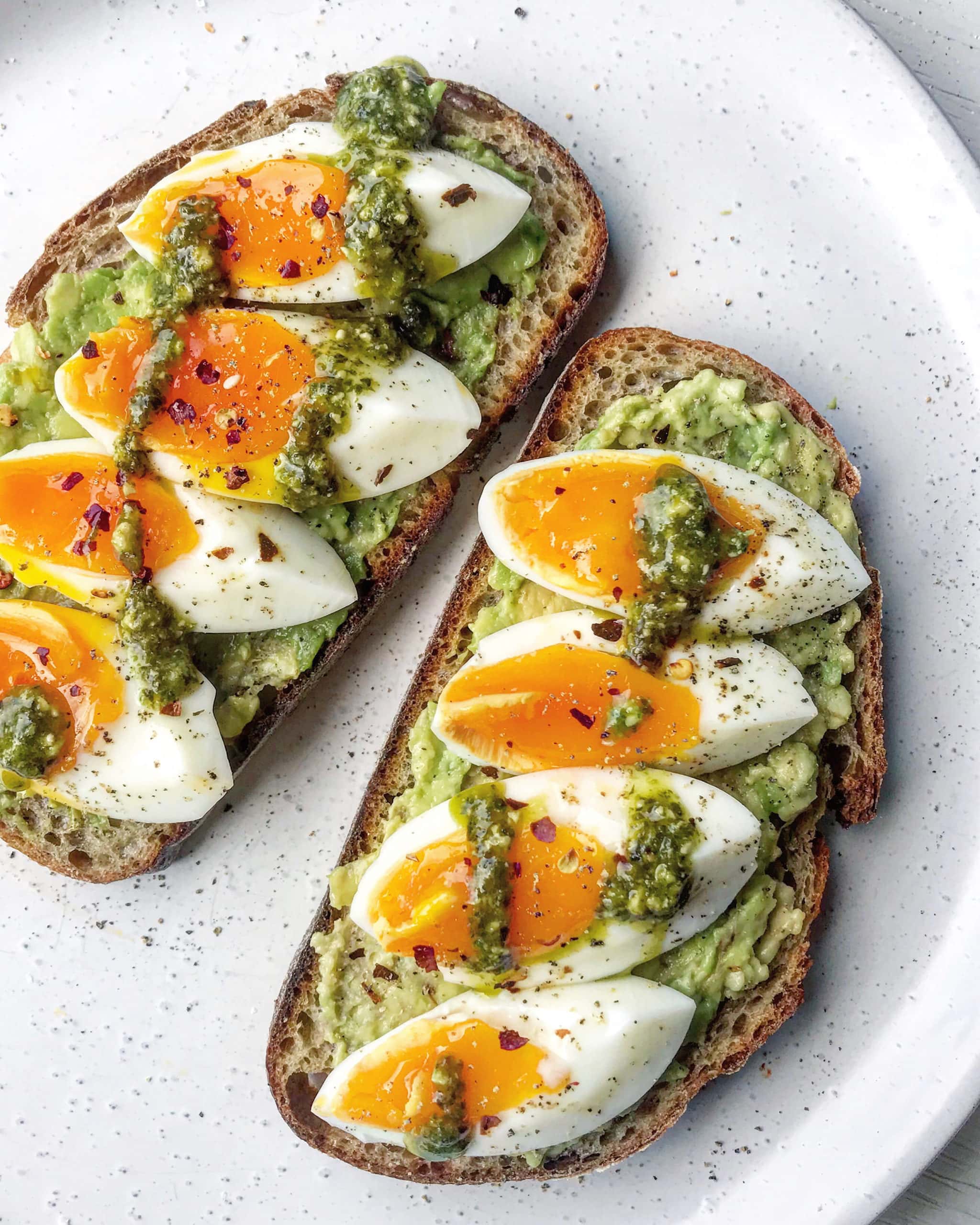
Ingredients:
Sourdough Bread
- 2 slices sourdough bread, with your choice of topping out of:
1) Fig, Lemony Ricotta & Thyme
- 6 heaped Tbsp ricotta
- 1 small lemon
- 2 fresh ripe figs
- 2 tsp mānuka honey
- 1 Tbsp finely chopped pistachios
- A very small bunch of thmye leaves
2) Nut Butter, Banana & Dark Chocolate
- 2 Tbsp peanut butter or another nut butter of choice
- 1 ripe banana, medium
- 2 squares of dark chocolate
3) Mānuka Honey & Butter
- 1 Tbsp mānuka honey
- 1 tsp butter
4) Egg, Pesto & Avocado
- ½ ripe avocado
- 2 boiled eggs
- 1 Tbsp pesto
5) Peanut Butter & Chia Jelly
- ½ cup berries, fresh or frozen
- 1 ½ Tbsp water
- ½ Tbsp sweetener of choice, maple syrup and honey
- ½ Tbsp chia seeds
- 2 Tbsp peanut butter
6) Margherita Pizza Toast
- 2 tsp olive oil
- 2 Tbsp pizza sauce
- 4 thin slices of mozzarella cheese
- A few fresh sprigs of basil
Method:
Toast Bread
- Put sourdough bread slices in the toaster. Toast to desired preference.
Toppings
- Option #1. Whisk the ricotta and lemon juice together, and spread on the toast. Top with sliced figs, finely chopped pistachios, thyme leaves and a drizzle of honey.Option #2: Spread the toast with nut butter. Top with sliced banana and chopped dark chocolate.Option #3: Spread toast with butter, then top with honey.Option #4: Spread toast with avocado. Top each slice with a quarter boiled egg and a drizzle of pesto.Option #5: Add berries to a small stove pot with water and sweetener. Gently heat and mash, until a thick puree has formed. Mix in chia seeds and leave to stand for 10 minutes, or until thickened. Spread toast with peanut butter and dollop overtop the chia jam. Option #6: Click here for the full Grilled Sourdough Margherita Pizza Toast recipe.


2 Comments
Hey Danijela! Just read this and loved how it was such an informative yet easy and light-hearted read 🙂 So cool, the bit about our hand bacteria and the reduction in bad bacteria.
Hi lovely, thank you for your kind words <3 Yes, isn't the bacteria thing fascinating?! Pretty nifty. Big hugs xx